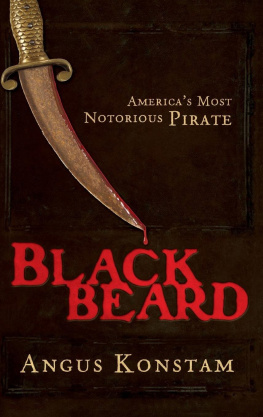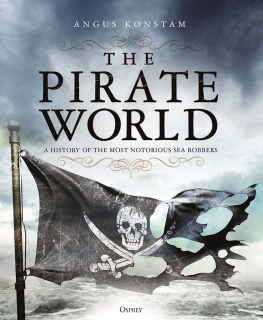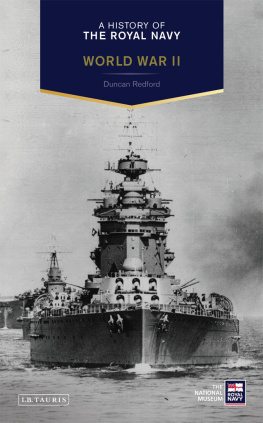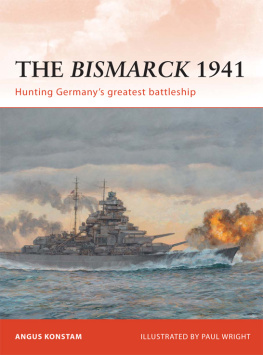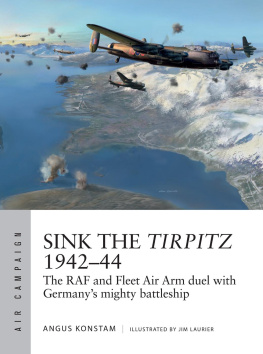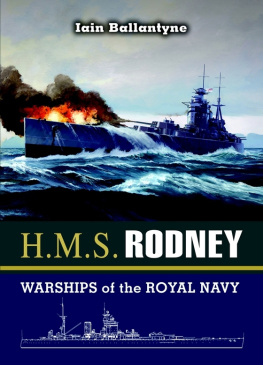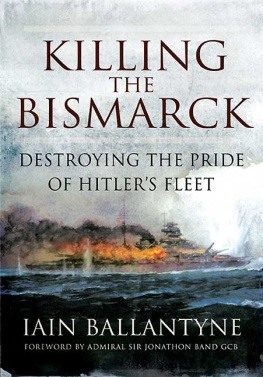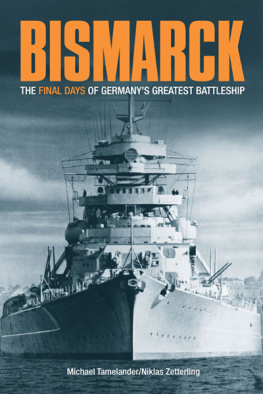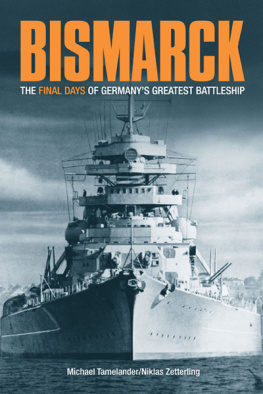

Contents
The clock on the bridge of the Bismarck read 05.53. At that moment, virtually everyone on the bridge was watching the two dark shapes on the southern horizon. Were they just British cruisers, or were they battleships? Then, the watchers saw a ripple of orange light erupt from the front of the lead ship. To some, it looked like a flash of lightning. They were firing. At a range of 25,000 yards (12.5 miles), a 15in. shell has a flight time of around 50 seconds. The men on the bridge could do nothing but wait. Seconds later, the same flashes were seen from the second British ship. Then, with a roar like an express train, the first shells arrived.
In fact, Hood was firing on Bismarck s consort, the cruiser Prinz Eugen , which was steaming ahead of the huge German battleship. That roar came from the shells fired by the second enemy ship, and when they landed a few hundred yards past Bismarck they threw up six huge water spouts. Those werent cruisers out there. Those shells had come from a battleship!
On the telephone, Korvettenkapitn (Lieutenant Commander) Schneider asked permission to open fire. His eight 15in. guns had been tracking the lead enemy ship, and he was ready. Someone shouted out The Hood its the Hood ! So, the target was the battlecruiser Hood that legendary icon of British seapower. Then, Kapitn Lindemann picked up the bridge telephone. Permission to open fire. Seconds later, Schneiders great guns erupted in similar flashes of orange flame. The duel had begun.
By then, the second British ship had been identified as one of the new King George V class battleships. She carried ten 14in. guns. Hood carried eight 15in. ones, as did Bismarck , while the Prinz Eugen only had eight 8in. guns. So, the Germans were outgunned, but far from outclassed. On both sides, the gunnery teams watched for the splashes as their shells landed, and corrected their aim. The range was still dropping, even though at 05.54 the German ships turned slightly to starboard. They had the edge now all their guns could fire, while only the front turrets on the British ships could bear on the enemy. Prinz Eugen s smaller guns had a greater rate of fire, so her shells were soon falling around the Hood , and she scored the first hit of the battle, and started a small fire. By now, though, the shells from the bigger guns were also straddling their targets.
Admiral Ltjens ordered the Prinz Eugen to switch her fire to the British battleship and to drop astern of Bismarck , so the German battleship had her own duel with the enemy battlecruiser. By her third salvo, Bismarck s shells were straddling Hood , their splashes falling all around her. They had found the range. So, at 05.59 Schneider fired three more rounds in quick succession, 30 seconds apart. By now the range was down to 18,000 yards (9 miles), and the flight time was just 30 seconds. The first of these straddled the Hood again, without scoring any hits. Then, at 06.00, with the Bismarck s fifth salvo, one of the German shells struck home.
Nobody really knows for certain what happened. Some observers on the German ships saw a pillar of flame rise up Then the helmsman reported the wheel wasnt responding. In fact, when the magazine exploded, the blast had ripped the stern off the ship.
On the Bismarck , Kapitnleutnant (Lieutenant) von Mllenheim-Rechberg was watching the pursuing British cruisers shadowing the German ships when he heard a voice on the intercom say, Shes blowing up. He quickly peered through the port-side gunnery director. There was no sign of the Hood . Where she should have been there was only a colossal pillar of black smoke. Then, at its foot, he made out the bow of the battlecruiser, sticking up out of the sea at an angle. It was true. Hood had been torn in two. As he watched, he saw another orange flash. It was the Hood s forward guns, firing one final salvo, her gun crews refusing to acknowledge that their ship was sinking beneath them.
On Bismarck s bridge, the ships navigator watched as the Hood split in two, and a fireball enveloped her. Then came the shockwave. Even 9 miles away from the blast, he felt every nerve being yanked out of his body. In those moments, or in the minutes that followed, the mangled battlecruiser became a great steel coffin for 1,415 of her crew. There were only three survivors.
On 18 May 1941, when the Bismarck sailed from Gotenhafen (now Gdynia in Poland), she was operating under Central European Time (CET), which was one hour ahead of Greenwich Mean Time (GMT). However, due to the season, this had been changed to Central European Daylight Savings Time (CEDST), which was two hours ahead of GMT (making it GMT+2). At the time, Great Britain was also operating in the same time zone, which they called British Double Summer Time (BDST). So, both British and German clocks were aligned, at GMT+2.
What complicates this is time zones. The further west a ship sails, the later sunset becomes. The North Atlantic spans five time zones, and so warships crossing from one zone to another would normally alter their ships clocks to conform to the new time zone. To simplify things, on 23 May, as his ships were approaching the Denmark Strait, Admiral Ltjens ordered that at 13.00 his force would switch to Central European Time, at GMT+1. That put them an hour in front of both their own naval headquarters in Berlin and the British Admiralty in London.
For the most part, British warships operating in the eastern region of the North Atlantic were also either one or two hours ahead of London, depending on the time zone in which they were operating. To simplify this, within the Home Fleet, signals were usually dated and timed in accordance with BDST. However, times in ships logs conformed to the time zone. To simplify all this, unless otherwise noted, the times in this book are given in CET (or GMT+1). So, for instance, Bismarck left her berth at Gotenhafen at 11.30 (CEDST). She remained in this time zone until the time of Ltjens switch to CET five days later, and so the narrative waits until 13.00 that day to switch to the new time zone, allowing the cumbersome CEDST label to be dropped.
Other conventions are more straightforward. A warships speed through the water is given in knots, which represent its speed in miles per hour. Since 1929, the mile was officially defined as 2,025 yards (1,852m). So, a ship moving at 30 knots will cover 30 miles in the space of an hour, or half a mile per minute. Incidentally, until 1970, the British still clung to an Admiralty mile, which was a yard longer. Historically, a mile equated to a minute of latitude, or one-sixtieth of a degree of latitude. A mile is divided into ten sub-units, called cables.
To confuse matters, for the sake of naval gunnery, a mile was defined as 2,000 yards (1,829m). These were sea miles, and so when the Hood engaged the Bismarck at a range of 25,000 yards (22,860m), that equates to 12.5 sea miles. The Germans, of course, calculated range in metres rather than yards. A sea mile is 2,000 yards (1,829m), and so is slightly shorter than a nautical mile, and a land mile is 1,760 yards (1,609m). So, the convention well adopt here is to give speed in knots, and therefore the distance travelled in nautical miles, while for gunnery, ranges will be given in yards or sea miles, rather than their equivalent in metres.
Finally, a word on courses and bearings. These are determined by the compass, divided into 360 degrees. The four cardinal points are North (0, or 360), East (90), South (180) and West (270). On a warship of this period, port lay to the left-hand side, and starboard to the right. These were linked to the colours used in navigation lights, with red representing port and green denoting starboard. To a shipboard observer looking forward, objects at roughly 90 degrees to the direction the ship was facing were deemed to be on the beam either to port or starboard. An object forward of this was deemed on the bow, and behind it as on the quarter. So, an enemy ship spotted ahead of the ship and to the left was deemed as being off the port bow.


